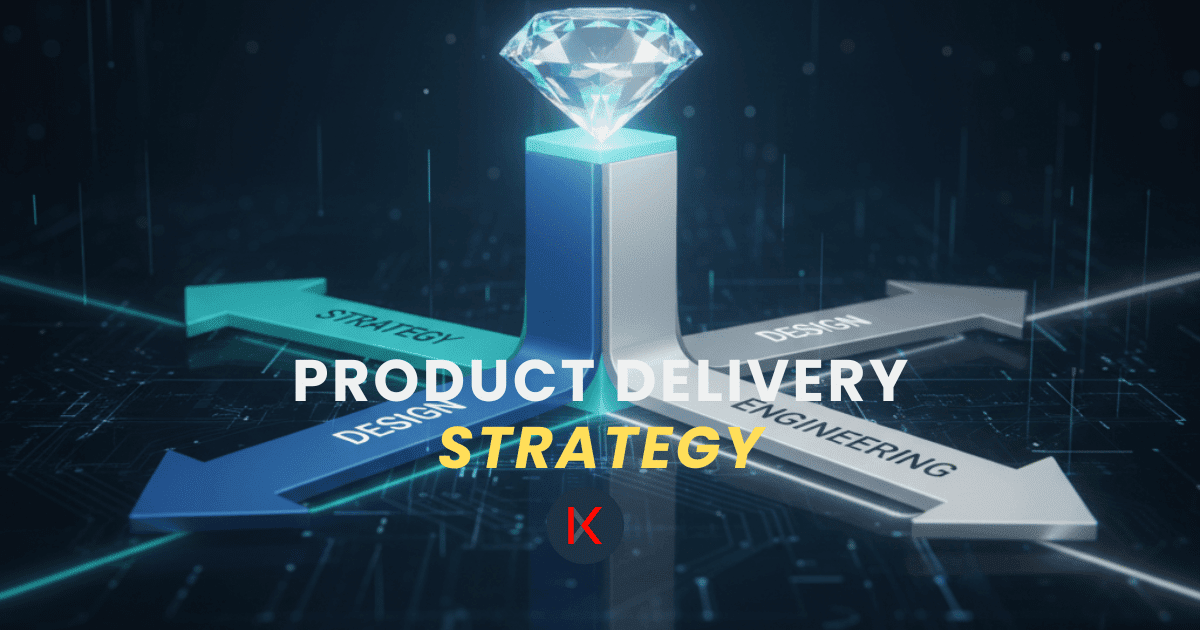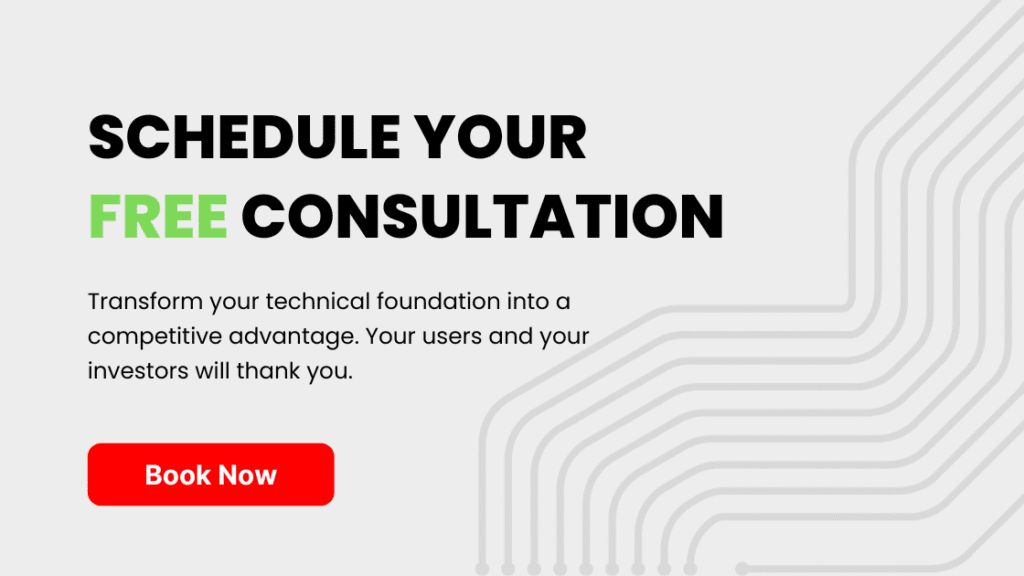Key Takeaways
- The failure of great products often lies not in poor code, but in a flawed Product Delivery Strategy that lacks End-to-End Development alignment.
- Strategy First—Focus must be on validating Product-Market Fit (PMF) before any major development begins.
- Design Integration—UX/UI must be treated as a core function, ensuring designs are both delightful and technically feasible.
- Velocity & Health—A high-performing strategy uses modern DevOps (CI/CD) and strategically manages Technical Debt.
- Cross-Functional Alignment—Breaking down functional silos and organizing teams around value streams guarantees shared ownership and faster execution.
- Governance & Data—Success is measured by business outcomes (revenue, adoption), not just feature output, powered by continuous data feedback loops.

Introduction: Why Your Talent Needs a Strong Product Delivery Strategy
It’s a common scenario: a company hires brilliant developers, funds ambitious projects, and yet, the resulting product falters. Why? The root cause is almost always a failure of the Product Delivery Strategy. The belief that a talented development team alone guarantees market success is the most expensive myth in modern business.
A successful product requires more than just code; it demands an intelligent, unified approach that manages the entire lifecycle—from the initial “Why” to the final deployment and scaling. At Kinetik Dynamics, we champion an End-to-End Development approach. This comprehensive strategy seamlessly integrates business goals, user experience, and technical excellence into one cohesive engine.
This guide reveals the 5 Keys to a Winning Product Delivery Strategy. We will detail the exact framework that ensures every investment in time and capital delivers maximum market impact, turning your development team from a cost center into a powerful driver of competitive advantage. Understanding this framework is essential for achieving true End-to-End Development mastery and securing your place as a market leader.
Key 1: Strategy First — Validating the Problem Before You Build
The very first key to a strong Product Delivery Strategy is ensuring you are building the right thing. This initial phase defines the strategic guardrails for all subsequent development, minimizing costly rework.
Product validation is important for everyone making anything they want to sell. And it takes different forms depending on the product you’re making. For instance, in B2B businesses the simple cost-effective methods of the lean product validation process help eliminate unnecessary building.

The Continuous Search for Product-Market Fit (PMF)
PMF is the state where your product satisfies a market need so effectively that users willingly pay for it and tell others. Your delivery strategy must prioritize validating this fit above all else.
- Continuous Discovery: This is an ongoing discipline, not a one-time project. Product Managers must constantly engage with target users, performing interviews and usability tests to validate assumptions.
- Outcome-Based Roadmaps: Stop listing features. Instead, define your roadmap based on desired business outcomes (e.g., “Reduce customer churn by 10%,” “Increase user adoption by 25%”). This ensures every effort ties back to a measurable strategic goal.
- The Technical Investment Balance: A mature Product Delivery Strategy explicitly dedicates capacity—typically 15-20%—for platform modernization and debt repayment. Ignoring this builds a brittle foundation, crippling future delivery velocity.
The Role of Clear Prioritization
Every team faces finite resources. A winning Product Delivery Strategy employs rigorous, objective prioritization methods to allocate resources to the highest-value work.
- Value vs. Effort Analysis: Use simple frameworks to score features based on the value they deliver to the user/business versus the engineering effort required to build them. High value and low effort always win.
- The Power of ‘No’: Strategy is defined as much by what you choose not to build. A disciplined delivery process empowers Product Owners to confidently say “No” to low-value requests, protecting the team’s focus on the strategic roadmap.
Key 2: Experience Design — The Bridge Between Strategy and Code
Design is not a coat of paint applied at the end; it is a critical component of the Product Delivery Strategy. Poor User Experience (UX) can sabotage the most well-coded application. The goal is to make the product intuitive, efficient, and accessible.
Integrating UX/UI into End-to-End Development
A strategic approach embeds the designer directly within the cross-functional delivery team, fostering true collaboration.
- Design Systems: The Velocity Booster: Implementing a comprehensive Design System (a library of reusable components and guidelines) standardizes the visual language and greatly accelerates End-to-End Development. Engineers spend less time coding styles and more time solving complex business logic.
- Feasibility and Fidelity: Designers must collaborate with engineers early and often to ensure that proposed solutions are technically feasible within budget and timeline constraints. This prevents costly “design throws” where engineers must heavily modify an unworkable concept late in the cycle.
- Prototype, Test, Iterate: The cheapest time to fail is early. A rapid cycle of low-fidelity prototyping and user testing allows the Product Delivery Strategy to kill bad ideas quickly before any development resources are wasted.
Key 3: Technical Velocity and Strategic Debt Management
This key focuses on how the code is built, deployed, and maintained. Even the most talented developers cannot achieve high velocity without an optimized technical process and a strategic approach to debt.
Achieving High-Velocity Delivery with DevOps
Modern Product Delivery Strategy is inseparable from a DevOps culture and best practices, enabling continuous, reliable flow of value.
- CI/CD is Non-Negotiable: Continuous Integration/Continuous Deployment (CI/CD) pipelines automate testing, building, and deployment. This allows teams to release new code reliably multiple times per day, drastically reducing the time-to-market and lowering release risk. [Outbound Link Suggestion: Link to a reputable source like the DORA research report on DevOps practices.]
- Infrastructure as Code (IaC): Managing and provisioning infrastructure through code (e.g., Terraform) standardizes environments. This consistency is vital for scaling and for ensuring that production environments are always stable and auditable—a core requirement for sound End-to-End Development.
Strategically Addressing Technical Debt
Technical Debt is the silent killer of delivery speed. It represents the cost of future rework incurred by making expedient choices today. A weak Product Delivery Strategy ignores it; a winning strategy manages it proactively.
- Debt Sprints: Dedicate explicit time (e.g., 20% of every sprint) for refactoring, updating libraries, and improving platform health. This is a non-negotiable investment in future speed.
- Strategic Refactoring: Don’t clean the whole house. Focus refactoring efforts on the areas of the code that are most frequently touched or are critical to business performance. This ensures the highest return on your debt repayment investment.
Key 4: Cross-Functional Alignment — Breaking Down the Silos
Silos between Product, Design, and Engineering are the enemy of an efficient Product Delivery Strategy. When teams only focus on their functional mandate, the holistic success of the product suffers.
Organizing Around Value, Not Function
The modern model for End-to-End Development organizes people into self-sufficient, cross-functional teams (often called “Pods” or “Squads”).
- Full Ownership: Each team contains all the expertise needed—Product, Design, QA, and Engineering—to take a feature from concept to deployment independently. This fosters a shared sense of ownership for the business outcome, not just the completion of a task.
- Shared Language and Metrics: The team must align on the vocabulary of the business problem and use a shared set of KPIs. When everyone measures success by the same metrics (e.g., user adoption rate), collaboration improves dramatically.
- The Integrated Role of QA: Quality Assurance (QA) is shifted from a final gatekeeper to an integrated participant (Shift-Left). Automated testing is written alongside the code, catching defects early, which is far cheaper than catching them late. [Internal Link Suggestion: Link to Kinetik’s specific approach to team structure and Agile implementation.]
Fostering a Culture of Transparency
A successful Product Delivery Strategy thrives on open communication. Transparency in decision-making and performance metrics builds trust and speeds up execution.
- Visible Roadmaps: All stakeholders should have access to a high-level view of the product roadmap and understand why certain priorities were chosen over others.
- Blameless Post-Mortems: When errors or outages occur, the focus should be on learning from the incident and improving the system, not on finding who to blame. This encourages an honest reporting culture essential for stability.
Key 5: Governance and Data — Measuring What Truly Matters
The final key dictates how you govern the entire process and measure its success. A winning Product Delivery Strategy measures business outcomes, not just engineering outputs.
The Feedback Loop: Deploy, Monitor, Learn
Your delivery strategy doesn’t end at deployment; it starts a new cycle of learning.
- Observability over Monitoring: Moving beyond simply checking if the system is up (monitoring), observability is about having enough granular data to understand why a customer is struggling or why a service is slow. This actionable data immediately feeds into the Product Delivery Strategy for the next cycle.
- A/B Testing as a Strategy: Every new feature should be viewed as an experiment. Deploying features as controlled A/B tests allows the team to scientifically validate whether a change yields the desired business outcome before a full rollout. [Outbound Link Suggestion: Link to a reputable source on A/B testing best practices, such as a large tech company blog or academic source.]
Partnering for Strategic Acceleration
For organizations seeking to implement a top-tier Product Delivery Strategy rapidly, strategic partnerships are invaluable. A true End-to-End Development partner brings immediate expertise across all five keys—strategy, design, engineering, and governance.
When evaluating partners, look for deep proficiency in:
- Challenging the ‘Why’: Do they focus on your business goals or just your feature list?
- DevOps Maturity: Can they immediately establish high-velocity CI/CD and manage technical infrastructure?
- Cross-Functional Talent: Do they provide integrated expertise in Product, UX, and Engineering, delivering the full Product Delivery Strategy under one roof?
Conclusion: Securing Your Competitive Edge with a Strong Product Delivery Strategy
The era of simply throwing code over the wall is dead. Today’s market leaders—the companies achieving true product success—are those that have mastered the 5 Keys to a Winning Product Delivery Strategy. By integrating strategy, design, and technical excellence into a unified End-to-End Development framework, you transform product creation from an unpredictable gamble into a repeatable, high-velocity engine of growth.
A strategic and disciplined delivery model is your single greatest competitive asset. It minimizes waste, ensures Product-Market Fit, and allows you to adapt to market changes faster than the competition.
Ready to stop building the wrong thing and start implementing a predictable, market-dominating Product Delivery Strategy?

Frequently Asked Questions (FAQ)
What is the primary difference between a development team and a Product Delivery Strategy?
A development team is the executor of code. A Product Delivery Strategy is the governing framework that determines the value, direction, quality, and speed of that execution. It ensures that the team builds the right thing, the right way, at the right time, minimizing technical debt and maximizing business impact.
How often should we allocate time for technical debt in our Product Delivery Strategy?
Ideally, dedicated time for technical debt repayment should be allocated in every development cycle (e.g., every sprint). A common best practice is to reserve approximately 15%−20% of the team’s capacity for strategic refactoring, platform health, and security upgrades to ensure long-term, sustainable delivery speed.
What does “End-to-End Development” mean in practice?
End-to-End Development is the process of owning the entire product lifecycle from initial conception (discovery and strategy) through design (UX/UI), technical execution (coding and DevOps), launch, and post-launch optimization. It eliminates the handoffs and silos that slow down traditional development and is central to a successful Product Delivery Strategy.
Which metrics are most important for measuring the success of a Product Delivery Strategy?
The most important metrics are business outcomes, not output metrics. Focus on:
- Feature Adoption Rate
- Customer Churn/Retention
- Revenue Impact per Feature
- Time-to-Value (TTV) for new features.
How can Kinetik Dynamics accelerate our Product Delivery Strategy?
Kinetik Dynamics acts as your strategic End-to-End Development partner. We instantly integrate the expertise needed for all 5 Keys—senior Product Strategists, UX/UI experts, and high-velocity DevOps engineers—to rapidly implement a modern delivery framework that is outcome-focused and scalable. Learn more about our End-to-End Development services here.
